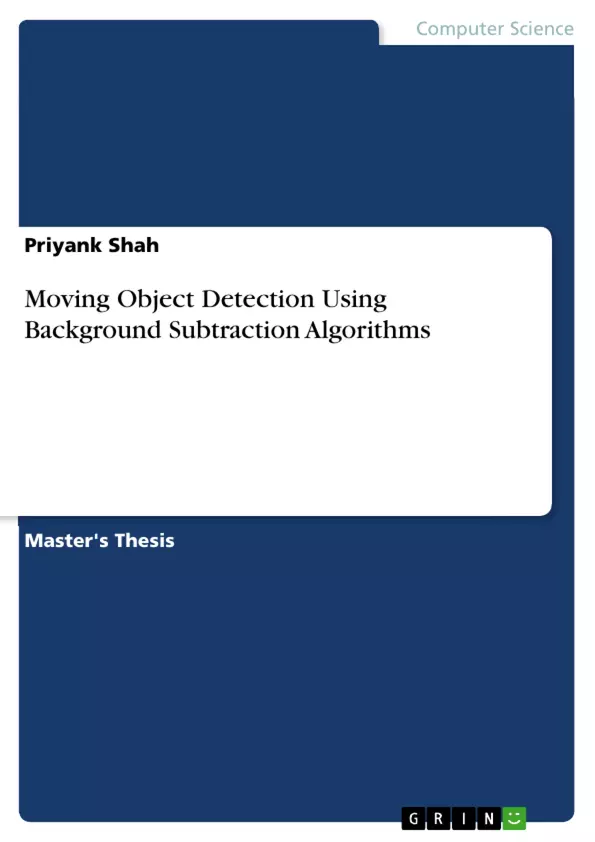In this thesis we present an operational computer video system for moving
object detection and tracking . The system captures monocular frames of
background as well as moving object and to detect tracking and identifies
those moving objects. An approach to statistically modeling of moving object
developed using Background Subtraction Algorithms. There are many
methods proposed for Background Subtraction algorithm in past years.
Background subtraction algorithm is widely used for real time moving object
detection in video surveillance system. In this paper we have studied and
implemented different types of methods used for segmentation in Background
subtraction algorithm with static camera. This paper gives good understanding
about procedure to obtain foreground using existing common methods of
Background Subtraction, their complexity, utility and also provide basics which
will useful to improve performance in the future . First, we have explained the
basic steps and procedure used in vision based moving object detection.
Then, we have debriefed the common methods of background subtraction like
Simple method, statistical methods like Mean and Median filter, Frame
Differencing and W4 System method , Running Gaussian Average and
Gaussian Mixture Model and last is Eigenbackground Model. After that we
have implemented all the above techniques on MATLAB software and show
some experimental results for the same and compare them in terms of speed
and complexity criteria. Also we have improved one of the GMM algorithm by
combining it with optical flow method, which is also good method to detect
moving elements.
Inhaltsverzeichnis (Table of Contents)
- ABSTRACT
- LIST OF FIGURES
- LIST OF TABLES
- CHAPTER 1: INTRODUCTION
- 1.1 Introduction
- 1.2 Problem Definition
- 1.3 Motivation
- 1.4 Aim and Objectives
- 1.5 Scope and Organization of the Dissertation
- CHAPTER 2: LITERATURE REVIEW
- 2.1 Introduction
- 2.2 History of Object Detection
- 2.3 Various Techniques for Object Detection & Tracking
- 2.4 Object Detection in Video Surveillance
- 2.5 Applications of Object Detection
- 2.6 Challenges in Object Detection
- CHAPTER 3: BACKGROUND SUBTRACTION ALGORITHMS
- 3.1 Introduction
- 3.2 Background Subtraction: Techniques
- 3.3 Simple Background Subtraction
- 3.4 Statistical Methods
- 3.5 Frame Differencing
- 3.6 W4 System
- 3.7 Gaussian Mixture Model
- 3.8 Eigenbackground Model
- CHAPTER 4: EXPERIMENTAL RESULTS & ANALYSIS
- 4.1 Introduction
- 4.2 Performance Evaluation Metrics
- 4.3 Experimental Results
- CHAPTER 5: OPTICAL FLOW BASED MOVING OBJECT DETECTION
- 5.1 Introduction
- 5.2 Optical Flow Techniques
- 5.3 Horn-Schunck Algorithm for Optical Flow
- 5.4 Implementation of Horn-Schunck Algorithm
- CHAPTER 6: COMBINED APPROACH FOR MOVING OBJECT DETECTION
- 6.1 Introduction
- 6.2 Combining Background Subtraction and Optical Flow
- 6.3 Implementation and Experimental Results
- CHAPTER 7: SHADOW DETECTION & REMOVAL
- 7.1 Introduction
- 7.2 Shadow Detection Techniques
- 7.3 Implementation and Experimental Results
Zielsetzung und Themenschwerpunkte (Objectives and Key Themes)
This dissertation focuses on developing a practical computer vision system for detecting and tracking moving objects in video sequences. The main objective is to explore and implement various background subtraction algorithms and techniques for efficient and accurate moving object segmentation.- Background Subtraction Algorithms
- Moving Object Detection and Tracking
- Video Surveillance and Security
- Computer Vision and Image Processing
- Performance Evaluation and Comparison
Zusammenfassung der Kapitel (Chapter Summaries)
- Chapter 1: Introduction This chapter introduces the concept of moving object detection and tracking, outlining the problem, motivation, and goals of the dissertation. It also defines the scope and structure of the research.
- Chapter 2: Literature Review This chapter presents a comprehensive overview of existing techniques for object detection and tracking, highlighting relevant research works, challenges, and applications in video surveillance and other fields.
- Chapter 3: Background Subtraction Algorithms This chapter delves into the theory and practice of background subtraction algorithms, discussing different methods such as simple subtraction, statistical techniques, frame differencing, and Gaussian Mixture Models (GMM). It provides a detailed explanation of each method, its advantages, and limitations.
- Chapter 4: Experimental Results & Analysis This chapter presents the experimental results obtained by implementing and evaluating the discussed background subtraction algorithms on real-world video sequences. It discusses performance metrics and compares the effectiveness of different methods.
- Chapter 5: Optical Flow Based Moving Object Detection This chapter introduces the concept of optical flow and explores its application in moving object detection. It focuses on the Horn-Schunck algorithm, explaining its theory and implementation for calculating optical flow.
- Chapter 6: Combined Approach for Moving Object Detection This chapter presents a combined approach that integrates background subtraction and optical flow techniques for improved moving object detection. It describes the implementation and evaluates its performance against other methods.
- Chapter 7: Shadow Detection & Removal This chapter explores the challenge of shadow detection and removal in video sequences. It discusses various techniques and presents experimental results demonstrating the effectiveness of shadow detection algorithms.
Schlüsselwörter (Keywords)
This dissertation revolves around the core concepts of moving object detection, background subtraction, video surveillance, computer vision, and image processing. It delves into various algorithms and techniques, including Gaussian Mixture Models, optical flow, and shadow detection. The research emphasizes performance evaluation, comparison, and practical implementation in real-world scenarios.- Citation du texte
- Priyank Shah (Auteur), 2014, Moving Object Detection Using Background Subtraction Algorithms, Munich, GRIN Verlag, https://www.grin.com/document/275108



